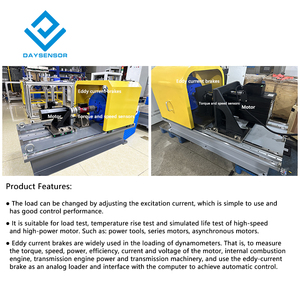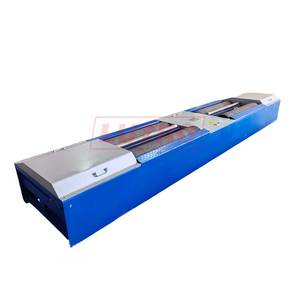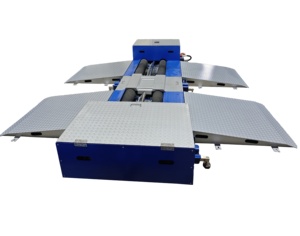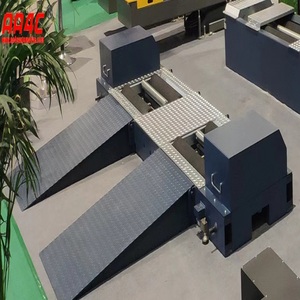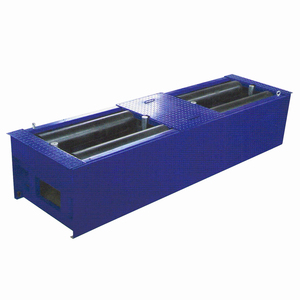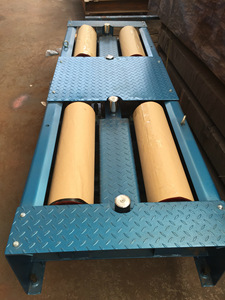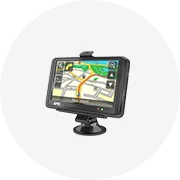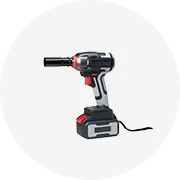Types of Roller Brake Testers
Roller brake testers are essential diagnostic equipment used to evaluate vehicle brake performance accurately and efficiently. They come in various configurations to suit different vehicle types, workshop needs, and testing requirements.
Single-Roller Brake Tester
Designed with a single roller mechanism, these testers offer accurate brake assessment for smaller vehicles. Their key advantages include:
- Portable and lightweight design
- Battery-operated for convenience
- Low maintenance requirements
- Cost-effective solution for small workshops
- Ideal for motorcycles and compact cars
Double-Roller Brake Tester
Featuring two parallel rollers, these systems provide independent measurement of each wheel's braking force. Benefits include:
- Enhanced stability during testing
- Superior accuracy for heavier vehicles
- Detailed analysis of brake system performance
- Widely used for buses, trucks, and commercial vehicles
- Better simulation of real-world braking conditions
Mobile Roller Brake Tester
Engineered for maximum flexibility and portability, these units excel in multi-location operations:
- Compact, lightweight construction
- No permanent installation required
- Battery-powered operation
- Rapid setup and teardown
- Perfect for mobile mechanics and service trucks
Integrated Roller Brake Tester
These systems work alongside other diagnostic equipment for comprehensive vehicle assessment:
- Combines with suspension testers and alignment systems
- Centralized data collection and analysis
- Complete vehicle performance evaluation
- Optimized workshop flow and efficiency
- Ideal for inspection centers and large garages
Electric Roller Brake Tester
Utilizing electric motors for roller operation, these testers provide precise control over testing parameters:
- Adjustable speed and load settings
- Advanced testing capabilities
- Ideal for detailed diagnostics
- Consistent testing conditions
- Higher accuracy in performance measurement
Wireless Roller Brake Tester
Incorporating modern wireless technology, these testers enhance operational flexibility:
- Real-time data transmission to display units
- Reduced cable clutter in workshop environments
- Remote monitoring capabilities
- Integration with workshop management software
- Enhanced operator mobility during testing procedures
Expert Insight:
When selecting between roller brake tester types, consider not only your current vehicle service mix but also your future business growth. Investing in a more versatile system initially may offer greater long-term value as your customer base expands.
| Tester Type | Best For | Key Advantages | Limitations |
|---|---|---|---|
| Single-Roller | Small vehicles, limited space | Portability, low cost, simple operation | Lower capacity, less stable for large vehicles |
| Double-Roller | Commercial vehicles, buses, trucks | Accuracy, stability, detailed analysis | Higher cost, larger footprint |
| Mobile | Multi-location operations | Flexibility, no installation required | Limited testing capacity |
| Integrated | Inspection centers, full-service shops | Comprehensive testing, workflow efficiency | Highest cost, complex setup |
| Electric | Advanced diagnostics | Precise control, adjustable parameters | Higher power requirements |
| Wireless | Modern workshops, tech-focused businesses | Connectivity, reduced cable clutter | Potential signal interference issues |
Specifications and Maintenance of Roller Brake Testers
Understanding the technical specifications and implementing proper maintenance practices ensures optimal performance and longevity of your roller brake testing equipment.
Key Specifications
| Specification | Description | Typical Range | Importance |
|---|---|---|---|
| Testing Capacity | Maximum load that can be tested | 10-30 kN (2,200-6,700 lbs) | Critical for determining suitable vehicle types |
| Roll Diameter | Diameter of testing rollers | 0.25-0.4 m (0.8-1.3 ft) | Affects grip and testing accuracy |
| Roll Length | Length of testing rollers | 0.3-0.5 m (1-1.5 ft) | Determines tire contact area |
| Test Speed | Roller rotation speed during testing | 5-20 km/h (3-12 mph) | Simulates real-world conditions |
| Power Consumption | Electrical power required | 1.5-10 kW | Affects operational costs |
Essential Maintenance Practices
Regular maintenance is crucial for ensuring accuracy, safety, and longevity of roller brake testers. Implement these key practices:
Daily/Weekly Tasks
- Surface Cleaning: Remove dirt, grease, and debris from rollers after each use
- Visual Inspection: Check for loose components, wear, and damage
- Roller Condition: Ensure rollers have proper grip and are free from contaminants
- Control System Check: Verify all controls and displays are functioning correctly
Monthly Tasks
- Lubrication: Apply lubricant to all moving parts per manufacturer specifications
- Electrical Connections: Inspect and clean all electrical connections
- Sensor Verification: Test all sensors for proper operation
- Software Updates: Apply any available software or firmware updates
Quarterly/Annual Tasks
- Calibration: Professional calibration to ensure accurate readings
- Motor Inspection: Check motor bearings and electrical systems
- Full System Test: Conduct comprehensive performance testing
- Structural Integrity: Inspect frames, mounts, and foundations
Important Maintenance Warning:
Always disconnect power before performing maintenance on electrical components of roller brake testers. Follow all manufacturer safety guidelines and use appropriate personal protective equipment when conducting maintenance procedures.
How to Choose the Right Roller Brake Tester
Selecting the optimal roller brake tester for your specific needs requires careful consideration of several key factors. This comprehensive selection guide will help you make an informed decision.
Vehicle Types and Fleet Composition
The types of vehicles your facility services should directly influence your choice:
- For passenger cars only: Single-roller or lightweight double-roller systems
- For mixed fleets: More versatile double-roller systems with adjustable parameters
- For heavy-duty trucks/buses: High-capacity testers with reinforced construction
- For performance vehicles: Look for systems with advanced data analysis capabilities
Pro tip: Consider your future business direction and potential fleet changes
Facility Space and Layout
Physical constraints play a crucial role in equipment selection:
- Measure available floor space precisely (width, length, height)
- Account for vehicle approach and exit paths
- Consider ceiling height for display mounting
- Evaluate floor composition and load-bearing capacity
- Check entrance dimensions for equipment delivery
Remember: Allow extra space for technician movement and safety zones
Power and Infrastructure Requirements
Evaluate your facility's electrical capabilities:
- Check available power supply (single-phase vs. three-phase)
- Compare with tester's power consumption requirements
- Consider potential electrical upgrades if needed
- Assess network connectivity for data-integrated systems
- Plan for proper drainage if in-ground installation
Important: Electrical work may require certified professionals
Data Management and Reporting Needs
Consider how test results will be used and stored:
- Basic printouts vs. digital records
- Integration with shop management software
- Customer report requirements
- Regulatory compliance documentation
- Historical data tracking capabilities
Calibration and Certification Requirements
Understand ongoing compliance needs:
- Required calibration frequency
- Local regulatory standards
- Certification authority requirements
- Availability of calibration services
- Self-calibration capabilities
Budget and Return on Investment
Evaluate the financial aspects thoroughly:
- Initial purchase price
- Installation costs
- Ongoing maintenance expenses
- Calibration service fees
- Potential revenue generation
- Expected equipment lifespan
Selection Strategy:
Create a weighted decision matrix that scores each potential roller brake tester on these key criteria based on their importance to your specific operation. This systematic approach helps ensure you select equipment that best matches your unique requirements rather than simply choosing based on price alone.
DIY Installation and Replacement Guide
While professional installation is recommended for complex systems, basic roller brake testers can be installed by those with appropriate mechanical skills. Follow this step-by-step guide for a successful DIY installation.
Pre-Installation Preparation
- Review Documentation: Thoroughly read the manufacturer's instructions before beginning. Pay special attention to safety warnings, component lists, and site requirements.
- Gather Tools and Equipment: Collect all necessary tools including screwdrivers, wrenches, level, electrical drill, measuring tape, and safety equipment.
- Prepare Installation Area: Clean the installation site thoroughly, removing all debris, dust, and obstacles that could interfere with proper installation.
- Verify Components: Unpack all parts and verify against the manufacturer's component list. Place them near the installation area for easy access.
- Check Electrical Supply: Ensure the available power supply matches the requirements of the roller brake tester. Consult an electrician if you're unsure.
Installation Process
- Mark Installation Position: Measure and mark the exact position where the brake tester will be installed. Use a measuring tape to ensure proper alignment with the service bay.
- Create Mounting Points: Drill holes for mounting hardware according to the manufacturer's specifications. Ensure holes are properly sized and positioned.
- Secure Base Structure: Mount the roller brake tester's base structure to the floor using appropriate anchors and fasteners. Check for level in all directions.
- Install Roller Assembly: Place the roller assemblies in position and secure them according to the manufacturer's instructions. Ensure proper alignment and spacing.
- Connect Control System: Install the control panel in the designated location and connect all necessary cables and wiring. Follow electrical safety protocols.
- Connect Power Supply: Have a qualified electrician make the final power connections to ensure safety and compliance with local electrical codes.
- Initial Testing: After installation, perform a "no-load" test of the system to verify all components function correctly before testing with a vehicle.
Post-Installation Calibration
- System Calibration: Follow the manufacturer's calibration procedure to ensure accurate test results. This typically requires specific tools or test weights.
- Verification Test: Conduct a complete test cycle with a vehicle of known brake performance to verify system accuracy.
- Documentation: Record all installation details, including calibration results, for future reference and compliance purposes.
Important Safety Warning:
DIY installation should only be attempted for basic roller brake tester models and by individuals with appropriate mechanical and electrical knowledge. Complex systems, especially those requiring in-ground installation or three-phase power, should be installed by certified professionals. Improper installation can result in equipment damage, inaccurate test results, or safety hazards.
Frequently Asked Questions
Regular brake testing is essential for vehicle safety and optimal performance. For private vehicles, conduct brake tests at every service interval (typically every 10,000-15,000 miles or annually). Commercial vehicles require more frequent testing, often quarterly or monthly depending on usage. Fleet vehicles should follow manufacturer recommendations and regulatory requirements, which may specify testing schedules based on mileage or time intervals. Remember that any unusual brake behavior (noise, pulsation, reduced effectiveness) warrants immediate testing regardless of the regular schedule.
Yes, specific roller brake testers are designed for heavy-duty trucks and commercial vehicles. These specialized units feature reinforced construction, higher capacity rollers, and more powerful motors to handle the substantial weight and braking force of large vehicles. When selecting a tester for trucks, verify the maximum axle weight rating (typically 10-30 kN or higher) and ensure the roller width accommodates wider truck tires. Heavy-duty testers also often include additional features like dual-direction testing and air brake system integration capabilities. Always check manufacturer specifications to confirm compatibility with your specific heavy vehicle types.
Digital roller brake testers offer significant advantages over manual systems in terms of precision, functionality, and user experience. Digital systems provide more accurate measurements with higher resolution and better repeatability. They typically include automated testing sequences, data storage capabilities, and comprehensive reporting features that manual systems lack. Many digital units integrate with workshop management software and can perform advanced diagnostics like brake force imbalance calculations and graphical analysis. However, manual testers remain viable for basic applications, have lower initial costs, and may be less sensitive to electronic failures. The best choice depends on your specific testing requirements, budget constraints, and technical capabilities.
It is strongly recommended that only properly trained personnel operate roller brake testers. Proper training ensures accurate test results, prevents equipment damage, and maintains safe operating conditions. Operators need to understand proper vehicle positioning, test sequences, result interpretation, and emergency procedures. Many jurisdictions require certification for brake test operators, especially for commercial vehicle inspections. Training programs are typically available from equipment manufacturers, industry associations, and technical schools. Even the most user-friendly roller brake testers require fundamental knowledge of vehicle brake systems and testing procedures to generate meaningful and reliable results.
With proper maintenance and regular servicing, a quality roller brake tester can operate effectively for 10-15 years. Higher-end models with robust construction may last even longer. Key factors affecting lifespan include testing volume, maintenance frequency, environmental conditions, and component quality. Rollers and bearings typically require replacement every 3-5 years depending on usage. Electronic components and sensors may need updating or replacement as technology advances. Many facilities choose to upgrade their testing equipment before the end of its mechanical lifespan to benefit from technological improvements in newer models.
Calibration frequency depends on usage volume, regulatory requirements, and manufacturer recommendations. Generally, professional calibration should be performed at least annually to ensure accuracy and compliance with testing standards. Facilities with high testing volumes or those conducting official vehicle inspections may require quarterly or semi-annual calibration. Many modern systems include self-diagnostic capabilities that can indicate when calibration is needed. Always maintain calibration records as they may be required for regulatory compliance and can help identify developing equipment issues. Calibration should also be performed after any major repair, component replacement, or if test results show unexpected variations.















